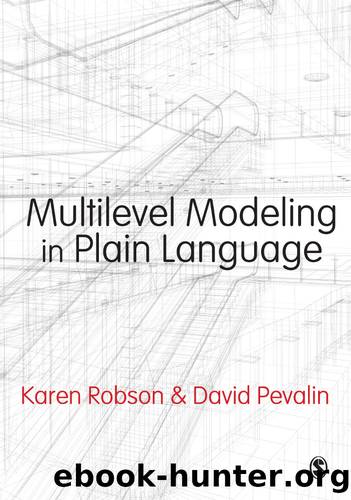Robson, Pevalin. Multilevel Modeling in Plain Language by Karen Robson & David Pevalin

Author:Karen Robson & David Pevalin
Language: eng
Format: epub
Published: 2015-10-27T15:06:20.974000+00:00
Getting started with random coefficient models
In a similar way to how we examined our data to see if a random intercept model was more appropriate than a single intercept one, we can first look at our data and determine if there is enough variation in the coefficients (slopes) to warrant further modeling in a multilevel framework.
There are a number of possible ways to go about this initial examination of the data, but here we start by running separate OLS regressions for each school and then examine results using some descriptive statistics and graphs.
We will continue with our example that investigates the effect of parental occupational status (the centred variable cen_pos) on standardized reading scores (z_read). The command statsby is useful for this procedure as it collects the value of the intercept and the coefficient for each regression and we tell Stata to save these results in a new data set, with one observation per school, which we will first inspect and then merge back into our working data for graphing. We called the saved data set ols.dta in this example.
statsby intercept=_b[_cons] coeff=_b[cen_pos], ///
by(schoolid) saving(ols, replace): reg z_read cen_pos
Now we open the ‘ols’ data set and produce some descriptive statistics. You could also examine some graphs if you prefer.
se ols, clear
su intercept coef
Download
This site does not store any files on its server. We only index and link to content provided by other sites. Please contact the content providers to delete copyright contents if any and email us, we'll remove relevant links or contents immediately.
| Biomathematics | Differential Equations |
| Game Theory | Graph Theory |
| Linear Programming | Probability & Statistics |
| Statistics | Stochastic Modeling |
| Vector Analysis |
Weapons of Math Destruction by Cathy O'Neil(5034)
Factfulness: Ten Reasons We're Wrong About the World – and Why Things Are Better Than You Think by Hans Rosling(4021)
Factfulness_Ten Reasons We're Wrong About the World_and Why Things Are Better Than You Think by Hans Rosling(2753)
Descartes' Error by Antonio Damasio(2731)
A Mind For Numbers: How to Excel at Math and Science (Even If You Flunked Algebra) by Barbara Oakley(2691)
TCP IP by Todd Lammle(2638)
Applied Predictive Modeling by Max Kuhn & Kjell Johnson(2478)
Fooled by Randomness: The Hidden Role of Chance in Life and in the Markets by Nassim Nicholas Taleb(2412)
The Book of Numbers by Peter Bentley(2402)
The Tyranny of Metrics by Jerry Z. Muller(2401)
The Great Unknown by Marcus du Sautoy(2184)
Once Upon an Algorithm by Martin Erwig(2147)
Easy Algebra Step-by-Step by Sandra Luna McCune(2115)
Practical Guide To Principal Component Methods in R (Multivariate Analysis Book 2) by Alboukadel Kassambara(2092)
Lady Luck by Kristen Ashley(2071)
Police Exams Prep 2018-2019 by Kaplan Test Prep(2032)
Linear Time-Invariant Systems, Behaviors and Modules by Ulrich Oberst & Martin Scheicher & Ingrid Scheicher(1982)
All Things Reconsidered by Bill Thompson III(1960)
Secrets of Creation, Volume 1: The Mystery of the Prime Numbers by Watkins Matthew(1864)
